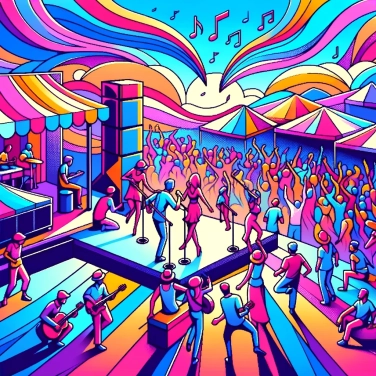Van Gogh used so much yellow in his paintings because of his interest in the brightness, warmth, and energy that this color symbolized for him. Additionally, he was influenced by the Impressionist painters who extensively used yellow in their works to represent natural light.

For Van Gogh, yellow represented above all an intense form of joy and light. He often associated this color with the sun, a symbol of vital energy and hope. Yellow also evoked his aspiration for a better and happier life, a kind of quest for optimism. The famous painting of Sunflowers illustrates this fascination well: these vibrant flowers symbolized for him warm friendship, the simple pleasure of sharing a welcoming home with Gauguin. Yet, despite this bright enthusiasm, his relationship with yellow sometimes seemed ambiguous, tinged with a certain melancholy: a dazzling light but always fragile.
Van Gogh often applied yellow in thick, dynamic layers, with very visible vigorous brushstrokes, giving his paintings a lively, somewhat vibrant feeling. He used intense yellow paint, such as chrome yellow, which was popular in his time, as it was a bright pigment capable of fully reflecting light, providing contrast, and making his works luminous. He also favored yellow alongside complementary colors, such as violet or blue, which fully enhanced the energy and radiance of yellow. The application of pure yellow in quantity, instead of mixing it too much with other shades, further amplified its visual intensity. In this way, his landscapes, wheat fields, or sunflowers almost appeared to vibrate or radiate light.
At the time of Van Gogh, many artists were influenced by Impressionism, a movement that valued bright colors, light, and visual impressions. He himself greatly admired Impressionist painters, notably Claude Monet, famous for his bright and colorful representations. Van Gogh was living in regions of southern France where the intense sunlight had a significant aesthetic importance, naturally encouraging artists to favor bright colors like yellow. He was also fascinated by Japanese prints, which were very trendy at the time and used bold, vibrant colors, many of which were yellows and oranges. All this highly colorful and luminous artistic context clearly influenced his intensive choice of yellow in his most famous canvases.
For Van Gogh, yellow was a kind of emotional color, a way to directly convey what he felt. He used this bright yellow as a tool to express deep feelings: hope, optimism, but sometimes also anguish. Some even see in this omnipresence of yellow a sign of the artist's unconscious quest for inner light, a fervent attempt to escape his own psychological suffering. Other specialists even speak of a possible link with his mental health, suggesting that the intensification of yellows would correspond to periods of more acute psychic crises, or to moments of great creative enthusiasm. Van Gogh himself considered yellow to be his lucky color to illustrate vital energy, as a simple way to transcribe his emotions onto the canvas.
In his famous painting 'The Sunflowers', Van Gogh wanted to express the idea of gratitude and deep friendship. He chose the color yellow because of its sun-like symbolism associated with comfort, warmth, and hope.
The yellow chrome pigment, highly regarded by Van Gogh, was known to be toxic because it contains lead chromate. At the time, its harmfulness was still largely unknown; however, Van Gogh regularly handled it without any special precautions.
Surprisingly, in some of his letters sent to his brother Theo, Van Gogh explicitly associated yellow with joy, the sun, but also with inner suffering, making yellow an ambivalent color in his work.
Van Gogh would sometimes paint at night by placing candles directly on his straw hat! This unusual method influenced his perception of colors, partly explaining his bold and expressive choices, particularly his use of vibrant yellows to see better in the darkness.
Yellow is often associated with light, hope, vitality, but also with emotion and even anxiety. For Van Gogh, this color likely symbolized a kind of spiritual comfort as well as a strong emotional and expressive charge that allowed him to convey his inner feelings in relation to the outside world.
Some historians and psychologists suggest that Van Gogh's abundant use of yellow could reflect his heightened emotional states or even the side effects of his medical treatment, particularly the digitalis administered to address his seizures. However, this hypothesis is debated, and one should be cautious about directly linking the color yellow to his mental health.
Although other Impressionist painters also used yellow tones, the luminous intensity, symbolic use, and particular frequency found in Van Gogh's work were quite unique. However, the growing interest in bright and expressive colors at the time, as seen in the works of Gauguin or Monet, may still have influenced Van Gogh's chromatic choices.
Sure! Here’s the translation: "Yes, at the beginning of his artistic journey, Van Gogh used a rather dull and dark palette, characteristic of Dutch realism. It was only after his discovery of the Impressionists in Paris that yellow gradually became brighter, more intense, and omnipresent in his work, particularly in Arles, where it reached its peak with his famous series of sunflowers."
Van Gogh particularly appreciated chrome yellow, a bright paint made from lead chromate that was commonly used in the 19th century. This vibrant pigment allowed him to achieve the intense brightness characteristic of his works, especially in his depictions of wheat fields, sunflowers, and other natural landscapes.

No one has answered this quiz yet, be the first!' :-)
Question 1/5